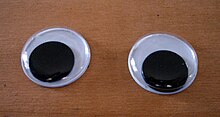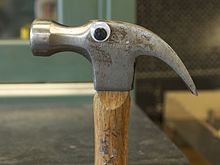
A doll is a model typically of a human or humanoid character, often used as a toy for children. Dolls have also been used in traditional religious rituals throughout the world. Traditional dolls made of materials such as clay and wood are found in the Americas, Asia, Africa and Europe. The earliest documented dolls go back to the ancient civilizations of Egypt, Greece, and Rome. They have been made as crude, rudimentary playthings as well as elaborate art. Modern doll manufacturing has its roots in Germany, from the 15th century. With industrialization and new materials such as porcelain and plastic, dolls were increasingly mass-produced. During the 20th century, dolls became increasingly popular as collectibles.

A stuffed toy is a toy doll with an outer fabric sewn from a textile and stuffed with flexible material. They are known by many names, such as plush toys, plushies, stuffed animals, and stuffies; in Britain and Australia, they may also be called soft toys or cuddly toys. The stuffed toy originated from the Steiff company of Germany in the late 19th century and gained popularity following the creation of the teddy bear in the United States in 1903. At the same time, German toy inventor Richard Steiff designed a similar bear. In 1903, Peter Rabbit was the first fictional character to be made into a patented stuffed toy. In 1921, Christopher Robin's stuffed toy, given to him by his father, A. A. Milne, would inspire the creation of Winnie-the-Pooh. In the 1970s, London-based Hamleys, the world's oldest toy store, bought the rights to Paddington Bear stuffed toys. In the 1990s, Ty Warner created Beanie Babies, a series of animals stuffed with plastic pellets that were popular as collector's items.

Pet Rock is a collectible toy made in 1975 by advertising executive Gary Dahl. They were rocks packaged in custom cardboard boxes complete with ventilation holes and straw bedding imitating a pet carrier. The fad lasted about six months, ending after a short increase in sales during the Christmas season of December 1975. Although by February 1976 they were discounted due to lower sales, Dahl sold over 1 million Pet Rocks for $4 each, and became a millionaire.

A product recall is a request from a manufacturer to return a product after the discovery of safety issues or product defects that might endanger the consumer or put the maker/seller at risk of legal action.

Barney Google and Snuffy Smith, originally Take Barney Google, for Instance, is an American comic strip created by cartoonist Billy DeBeck. Since its debut on June 17, 1919, the strip has gained a large international readership, appearing in 900 newspapers in 21 countries. The initial appeal of the strip led to its adaptation to film, animation, popular song, and television. It added several terms and phrases to the English language and inspired the 1923 hit tune "Barney Google " with lyrics by Billy Rose, as well as the 1923 record "Come On, Spark Plug!"
George Lerner (1922–1995) was an American inventor known for inventing the toy Mr. Potato Head.

Polyoxymethylene (POM), also known as acetal, polyacetal, and polyformaldehyde, is an engineering thermoplastic used in precision parts requiring high stiffness, low friction, and excellent dimensional stability. As with many other synthetic polymers, it is produced by different chemical firms with slightly different formulas and sold variously by such names as Delrin, Kocetal, Ultraform, Celcon, Ramtal, Duracon, Kepital, Polypenco, Tenac and Hostaform.

William Morgan DeBeck, better known as Billy DeBeck, was an American cartoonist. He is most famous as the creator of the comic strip Barney Google, later retitled Barney Google and Snuffy Smith. The strip was especially popular in the 1920s and 1930s, and featured a number of well-known characters, including the title character, Bunky, Snuffy Smith, and Spark Plug the race horse. Spark Plug was a merchandising phenomenon, and has been called the Snoopy of the 1920s.

"Try Honesty" is the debut single by Canadian group Billy Talent. It was released in July 2003 as the lead single from their debut self-titled album.

Beverly Buchanan was an African-American artist whose works include painting, sculpture, video, and land art. Buchanan is noted for her exploration of Southern vernacular architecture through her art.

Cat play and toys incorporates predatory games of "play aggression". Cats' behaviors when playing are similar to hunting behaviors. These activities allow kittens and younger cats to grow and acquire cognitive and motor skills, and to socialize with other cats. Cat play behavior can be either solitary or social. They can play with a multitude of toys ranging from strings, to small furry toys resembling prey, to plastic bags.
Rafaël Rozendaal is a Dutch-Brazilian visual artist currently living and working in New York City. He is known as a pioneer of Internet Art.
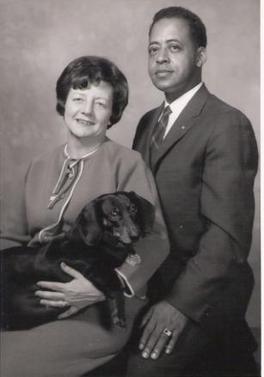
Barney and Betty Hill were an American couple who claimed they were abducted by extraterrestrials in a rural portion of the state of New Hampshire from September 19 to 20, 1961. The incident came to be called the "Hill Abduction" and the "Zeta Reticuli Incident" because two ufologists connected the star map shown to Betty Hill with the Zeta Reticuli system. Their story was adapted into the best-selling 1966 book The Interrupted Journey and the 1975 television film The UFO Incident.

Everything is a simulation game developed by artist David OReilly. It was released for the PlayStation 4 on March 21, 2017, for Microsoft Windows and macOS on April 21, 2017, and for Linux on April 28, 2017. A Nintendo Switch version of the game was released on January 10, 2019. It was released in Japan on February 13, 2020. The player takes control of various lifeforms and inanimate objects, exploring the manually generated world and finding new things to control. Everything features quotations from philosopher Alan Watts and has no clear goal aside from occupying more objects within the game.
Margaret Garrett, is an American artist and dancer. Her artistic practice includes painting, printmaking, collage, and video work. She lives and maintains a studio in Shelter Island, New York with her husband, the composer and pianist Bruce Wolosoff. She has two daughters, the singer-songwriter Juliet Garrett and the sculptor and mixed media artist Katya Wolosoff.

Untitled is a painting created by American artist Jean-Michel Basquiat in 1982. The artwork, which depicts a skull, is among the most expensive paintings ever. In May 2017, it sold for $110.5 million at Sotheby's, the highest price ever paid at auction for artwork by an American artist in a public sale. That record was surpassed by Shot Marilyns by Andy Warhol, which sold for $195 million in May 2022.
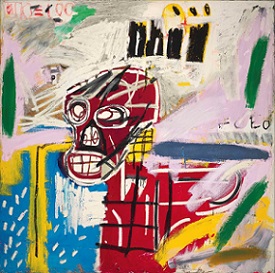
Red Skull is a painting created by American artist Jean-Michel Basquiat in 1982. It was sold for $21.6 million at Christie's in October 2017.
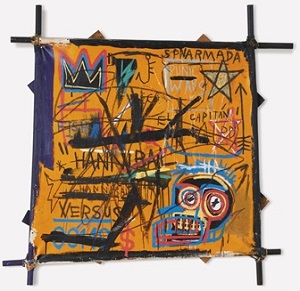
Hannibal is a painting created by American artist Jean-Michel Basquiat in 1982. The artwork, which features his signature skull and crown motifs, was sold at Sotheby's for $13.1 million in October 2016.
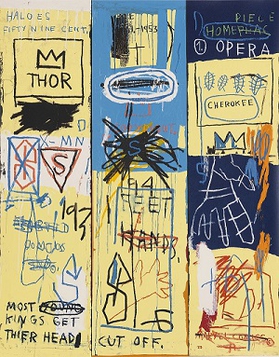
Charles the First is a painting created by American artist Jean-Michel Basquiat in 1982. The artwork is a tribute to jazz musician Charlie Parker, and it was the basis for rapper Jay-Z's 2010 song "Most Kingz."

Versus Medici is a painting created by American artist Jean-Michel Basquiat in 1982. The artwork, which references the Medici family, sold for $50.8 million at Sotheby's in May 2021.
